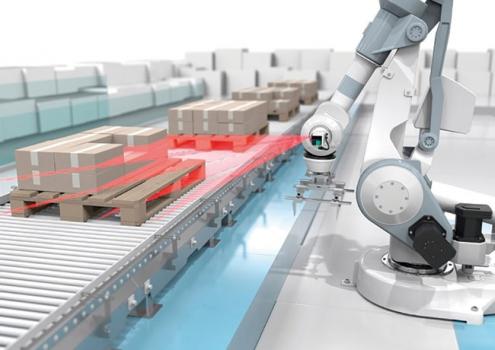Reliable Object Detection with Multi-Layer Scanner

Description
The compact and space-saving R2300, with a height of just 58 millimeters, is a 3-D LiDAR (Light Detection And Ranging) sensor for optical angle and distance measurement in stationary and mobile applications. The device uses four slightly offset scan planes, generated by a rotating mirror inside the sensor housing, to perform noncontact 3-D scanning of its surroundings.
The R2300 has a measuring range opening angle of 100°, a large measuring range of up to ten meters on bright objects and up to four meters on dark surfaces, a measuring rate of 50 kHz, and selectable scan rates of 12.5 Hz and 25 Hz with up to 4000 pixels per scan. These features enable the multi-layer scanner to cover the most important requirements of a wide range of applications. In addition, the monitoring field can be customized either by selectively hiding areas outside of the detection field or by installing a second R2300 alongside the first device, thus increasing the field of view to 180°. A distinguishing feature of 3-D sensors is the small—and therefore high—angular resolution of only 0.1°, which no comparable LiDAR or multi-layer sensor can currently achieve. In combination with the precise infrared light spot typical of lasers, the R2300 is able to reliably detect intricate object structures and contours.
The possible applications of the R2300—including fields such as intralogistics, mobile equipment, and robotics—meant that the multi-layer scanner required an especially rugged design. For this reason, the sensor housing is constructed from durable plastic material and the electronics in the sensor head are fixed components, providing effective protection against vibrations. The Pulse Ranging Technology (PRT) in the R2300 ensures not only a high degree of independence from object and surface properties, but also a high level of resistance to interference from extraneous light, HF lamps, and optical reflections from the application environment. Another unique selling point of the R2300 in the multi-layer scanner market is the mechanical separation of the emitter and receiver within the optical unit. The separating element in the sensor head reliably prevents optical short circuits that can occur if the front panel is dirty and part of the emitted light is directly reflected back onto the receiver element. This ensures that the R2300 always provides correct measurement results and a high level of detection reliability in practice, while at the same time significantly reducing maintenance costs. For the user, this means less downtime, significantly longer cleaning intervals, and improved availability and process reliability.
